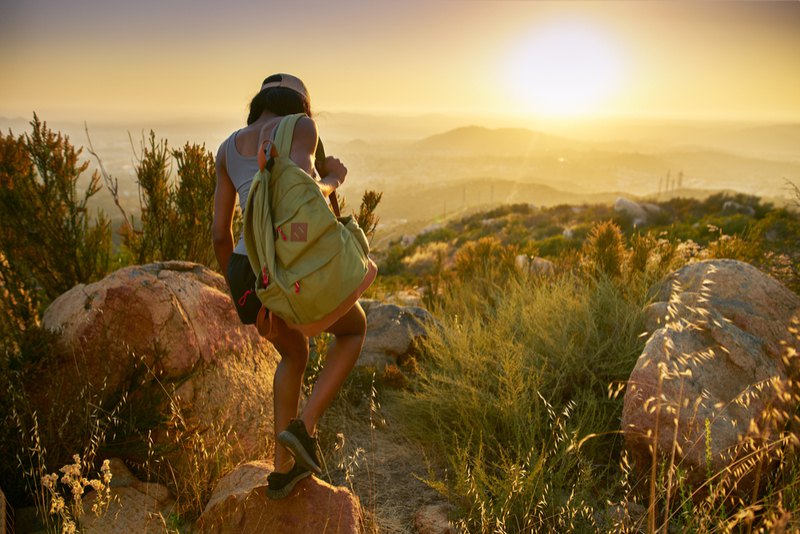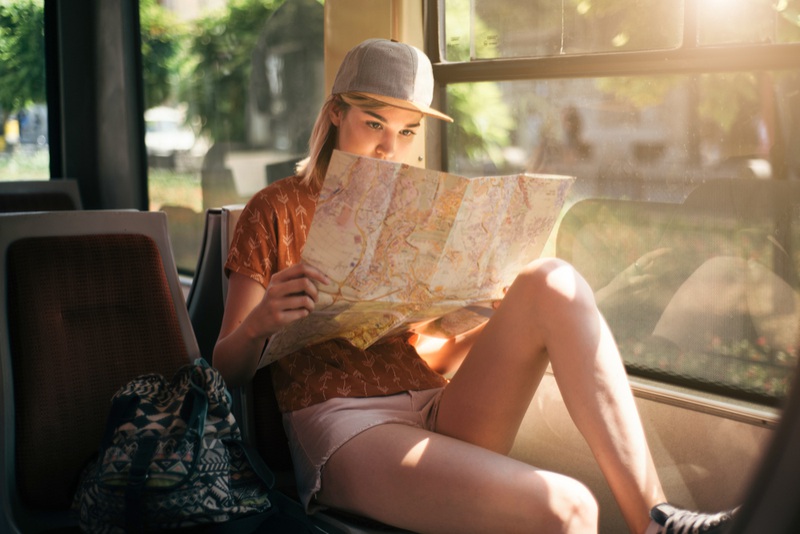How to Practice Mindfulness When Traveling in California
It’s just as important to practice mindfulness when traveling as it is to practice mindfulness at home. Perhaps, it’s even more important.
Being mindful, simply put, means living in the moment. When we travel, “living in the moment” often translates into unhealthy choices in the name of getting the full experience of a destination. Indulging in food and drink, missing out on sleep, overexertion, and ignoring self-care practices just to name a few.
By not being mindful when you travel, you risk losing sight of the positive impact a trip can make on you. You miss out on realizations and new lessons learned, and dismiss any real personal change that may happen.
Being mindful looks different for everyone. So, this month’s guest writer broke down nine different ways to practice mindfulness when traveling, focusing on travel in California. Although, these tips can (and should) be used in any destination you travel to.
How to Practice Mindfulness When Traveling in California
Mindfulness: Experiencing the present moment exactly as it is, without resistance or judgment.
Travel is a liberating experience. It opens you up to new cultures and new possibilities — it can give you the ultimate freedom and autonomy. With that being said, travel can also be lonely and daunting.
How do you stay grounded and healthy throughout such drastic changes in your environment?
Mindfulness is just as important on the road as it is at home, so we’ve come up with nine tricks to help you stay present and happy when exploring the Golden State.
1. Remember Your Intentions
While on the road, it can be easy to get caught up in the rush and lose sight of what your experience is about. Whenever you arrive at a new location, write down why you have chosen to be there, what you want to achieve there, and how you plan to grow as a result. This small act will remind you of your purpose in difficult times, as well as comfort you when you feel uncertain or in denial of the impact your travel is having.
If you want to, share your intentions with fellow travelers and ask if they have anything to contribute or share. This type of exchange can be an intimate moment that brings people closer together, a wonderful bonding experience between strangers.
2. People Watch
Humans can learn so much from each other’s behavior and customs, and when better to absorb this than in a foreign place. The best way to really feel a new location is to observe the locals. Of course, we don’t mean stare excessively — rather pull up a chair at an outdoor cafe and soak in the atmosphere.
The architecture, the fashion, how people greet each other, the language and other details that are easily missed in the day-to-day hurry.
It’s a wonderfully quiet way to explore without ever having to move. People in Santa Cruz and people in San Diego are very different. Study the differences. There’s a lot to learn.

3. Disconnect From WiFi
“Meditation is the ultimate mobile device; you can use it anywhere, anytime, unobtrusively.” – Sharon Salzberg
Part of the fun of traveling is being able to show off to your friends and family back home. Posting a “casual” image of you at the beach in San Diego or cycling across the Golden Gate Bridge and waiting for the likes to roll in is great.
But consider how social media forces you to live virtually, rather than in what’s actually happening now. It’s impossible to be present when you’re distracted by people’s perception of you elsewhere. Have a day without any internet and you’ll immediately notice that you check your phone less and concentrate on doing more, as opposed to trying to frame it.
Alternatively, if you don’t think you have the self-discipline to go without social media, put yourself in a scenario where WiFi isn’t an option. Go hiking through Yosemite National Park, trade your phone for a snorkel and discover the sea life at La Jolla in San Diego, or book a few days at Camp Grounded, a site specially designed for adults to unplug in the beautiful outdoors of Mendocino.
If you’re nervous about not having contact with people at home, let them know in advance that you won’t be reachable. The first hours may be tough, but you’ll soon find yourself forgetting all about your technology and appreciating your experience for you, not for your online community.
4. Pack Light
This is an important one. It’s easy to over-prepare and overpack for your vacation. It’s also easy to accumulate things on your travels, but you’re the one who has to carry it all on your back (or if you have a suitcase, pull it along).
The physical weight can become more of a burden as you do activities and take different modes of transport. Keeping your baggage to a minimum is a brilliant way to feel reassured that you have everything you need because you’ve only packed essentials.
If you end up needing additional bits, ask the people around you! Sharing or giving recommendations is what defines travel — it’s the most random sequence of events that become the most memorable. You’ll be glad you left space for the few bits that remind you of your authentic California getaway. And remember that California weather tends to be consistent and so you won’t have to pack for extreme weather changes.
5. Don’t Plan
On your travels, you’ll probably want to embrace everything, and that’s a great attitude to have. But you’re still a human being, you’ll get tired, you’ll get grumpy and you’ll get frustrated.
Let go of the urge to organize every day so to fit everything in. While having a couple of must-visit places, or an outline of what you want to do is good, if you make a strict itinerary, you may become sucked into time-keeping and logistics.
Instead, try to wake up at a reasonable time each day, and select a particular area, or type of activity you want to do, and allow the rest to unfold accordingly. Who knows, getting lost in a forest of Redwoods might end up being the highlight of your trip. Tough to plan that.

6. Be Still, Meditate
Traveling often translates as being in a permanent state of movement — walking from the train station to your hostel, cycling through the city streets, dancing in the evening, even surfing the rolling the waves of the Pacific. You might find yourself not only physically tired but also mentally tired.
Among all your activities, it’s useful to take some time to relax and reflect. Something as simple as being still for a few hours can drastically help recharge you.
Find a spot where you won’t be disturbed and where you feel at peace. This can be out in nature, inside a quiet building, or even just in your bed. Luckily, California makes it pretty easy to find these places.
Wherever you choose to be, make sure your spine is straight and your shoulders in line with your hips, and your facial muscles relaxed. Close your eyes, take deep breaths in through your nose and out slowly through your mouth. Focus on your diaphragm expanding and contracting, and concentrate on feeling your environment: the warm weather on your skin, the soft texture beneath you, the silence around you.
If you prefer to be with other people, guided meditation classes are available in Los Angeles at UCLA. Elsewhere, head to a silent retreat in Solano County, which is just north of San Francisco.
7. Collect Items of Significance
Don’t worry, we’re not encouraging you to buy something from every souvenir shop or purchase a t-shirt with the California bear on it.
Rather, keep hold of small things that you can carry forward with you on your travels. The idea is that these little items remind you of something huge. For example, a ticket stub for a festival, a map of a museum, a stone from a beach — anything that was an experience of substantial impact.
As humans, we place great value on things — which doesn’t have to be negative — and these things can trigger strength in us when we need it most. Not to mention the bits serve as a great prop for when you recount your stories to people back home.
8. Make a New Relationship
Not necessarily a romantic relationship, but a connection with someone or something new. Strike up a conversation with a street vendor, ask about their life, what they like, what their plans are for the future.
Give a street performer a compliment, tell the hostel owner something personal about yourself. Be open and genuine. People can tell when you’re being sincere and making an effort. You may be surprised at how reciprocal your new friends are.
Californians tend to be pretty open so don’t be shy.

9. Get Lost and Found
You’re in a new place, you don’t know how to get around, and the street names seem like a random order of letters. You’re bound to spend hours stumbling around with a map in hand and a permanent confused frown.
And you know what? That’s totally OK.
Part of the process is being unfamiliar. It’s almost worth being lost for the eventual eureka moment of knowing exactly where you are, and feeling like a location is finally yours. In the moments when you don’t know where you are, look up, take a few deep breaths, and remind yourself that this is the beginning of the journey. The destination wouldn’t be worth the effort if it was easy to find, and whatever happens, you’re going to get there.
Pro Tip: Find the perfect accommodation to stay mindful in California on AllTheRooms, the world’s first vacation rental search engine.
My Health & Wellness Resources page contains helpful sites, phone numbers, and information for anyone needing mental health + wellness assistance.
About the Author
Grace Brennan is a writer and copywriter from the U.K. She’s had the pleasure of living in 5 countries, combining her two loves: language and travel. She currently lives in Medellín, Colombia.
- Like
- X
- Digg
- Del
- Tumblr
- VKontakte
- Buffer
- Love This
- Odnoklassniki
- Meneame
- Blogger
- Amazon
- Yahoo Mail
- Gmail
- AOL
- Newsvine
- HackerNews
- Evernote
- MySpace
- Mail.ru
- Viadeo
- Line
- Comments
- Yummly
- SMS
- Viber
- Telegram
- Subscribe
- Skype
- Facebook Messenger
- Kakao
- LiveJournal
- Yammer
- Edgar
- Fintel
- Mix
- Instapaper
- Copy Link